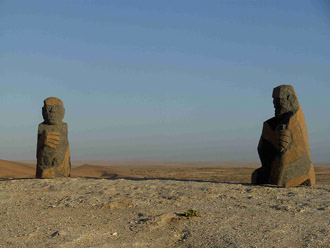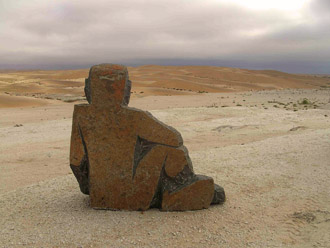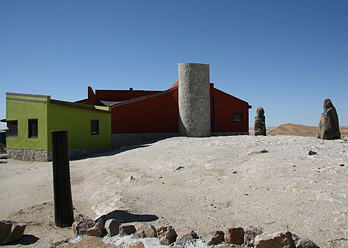Project Desert Breeze
Material: Dolerit, Namibia
Place of exhibition: Desert Breeze Lodge, Swakopmund, Namibia




Namibia
The Namibian landscape consists primarily of central highlands, of which the highest point is the Brandberg at 2,606 metres (8,550 ft). The central plateau runs from north to south, bordered by the Namib Desert and its coastal plains to the west, the Orange River to the south, and the Kalahari Desert to the east.
A remarkable strip of land in the northeast, known as the Caprivi Strip is the vestige of a narrow corridor demarcated for Germany to access the Zambezi River. The Namibian climate ranges from desert to subtropical, and is generally hot and dry; precipitation is sparse and erratic. The cold, north-flowing Benguela current accounts for some of the low precipitation. Besides the capital city Windhoek in the centre of the country, other important towns are the ports of Walvis Bay and Swakopmund, as well as Oshakati, Grootfontein, Tsumeb and Keetmanshoop.
(out: Excerpts from Wikipedia)
Geological outline
The geology of Namibia can be divided into several geotectonic and lithologic domains. The oldest domain belongs to the Paleoproterozoic Vaalian to lower Mokolian, followed by the Mesoproterozoic middle to upper Mokolian rocks (Republic of Namibia - Ministry of Mines and Energy 1992). The sedimentary and volcanogenic succession of the Neoproterozoic Damara Belt comprises more than 60% of Namibia’s rock outcrops. This northeast - southwest striking belt is folded and metamorphosed with the metamorphic grade progressively increasing towards the axial centre of the fold belt. Granites occur in the central part of the Damara Belt (Martin 1965; Martin and Porada 1977).
A relatively undeformed syn- to post-orogenic succession of the Cambrian Nama Group covers parts of southern Namibia. The terrestrial Kalahari Beds of Tertiary to Recent age are predominantly unconsolidated aeolian sand dunes and occupy large parts of eastern Namibia.
Pan-African and early Cretaceous alkaline ring complexes and carbonatites occur along a north-east trending structural zone, a continental expression of an extensive transform fault that offsets the Mid-Atlantic ridge (Marsh 1972).
(out: www.uoguelph.ca)
or look at: Geological Survey of Namibia


